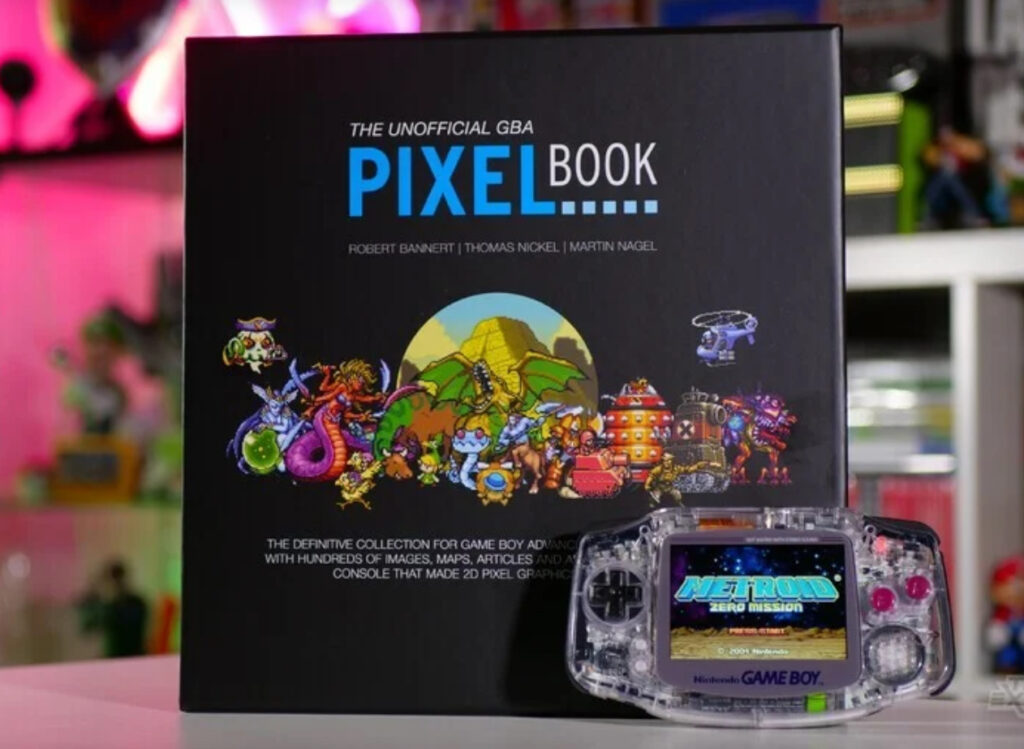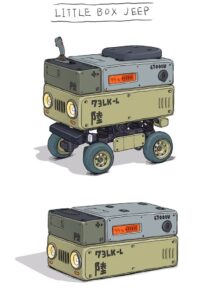
In the history of gaming, few consoles have enjoyed the cultural resonance of the Game Boy Advance (GBA). Launched in 2001, the GBA bridged the gap between retro gaming’s pixelated glory and the emerging era of 3D dominance. It marked the last bastion of true 2D artistry, boasting vibrant visuals and some of the most inventive games ever created. Now, decades later, the GBA Pixel Book pays homage to this iconic handheld console, offering a meticulously curated celebration of its legacy.
A Window Into Gaming’s Past
The GBA Pixel Book is more than a coffee table art book—it’s a time machine. Designed to showcase the full potential of pixel art at its zenith, the book dives deep into the visual legacy of the Game Boy Advance. Each page is a lovingly crafted celebration of the sprite work, color palettes, and animations that defined the handheld era.
The GBA, though limited by modern standards, boasted a 32-bit processor and a display that brought 2D graphics to life with vivid clarity. Games like The Legend of Zelda: The Minish Cap, Castlevania: Aria of Sorrow, and Advance Wars exemplify the mastery of pixel art, and the Pixel Book immortalizes these titles with high-resolution spreads and thoughtful commentary. The editors understood what made the GBA special: its ability to compress entire worlds into tiny, hand-drawn details.
The GBA’s Legacy in Pixel Art
To understand the Pixel Book’s brilliance, one must first appreciate the GBA’s unique place in gaming history. It was the last mainstream console to prioritize 2D visuals, arriving at a time when the gaming industry was fixated on 3D graphics. Titles on consoles like the PlayStation 2 and Xbox relied on polygons and textures, but the GBA carved a niche for pixel-perfect artistry.
Consider Golden Sun, which showcased dynamic battle animations and intricately detailed environments that belied the system’s hardware limitations. The Pixel Book captures these moments with full-page spreads, zooming in on individual frames to highlight the craftsmanship behind every pixel. It’s a testament to the skill of developers who worked within constraints to create something timeless.
What Makes the Pixel Book Stand Out?
Design and Presentation
The GBA Pixel Book itself is a work of art. Encased in a hardbound cover reminiscent of the GBA’s iconic Purple Glacier colorway, the book feels like an extension of the console it celebrates. The pages are printed on high-quality matte paper, giving each image a tactile richness that digital screens simply can’t replicate.
The layout is equally impressive. Each game featured in the book gets its own chapter, blending in-game screenshots, behind-the-scenes artwork, and interviews with developers who worked on these titles. For fans of Metroid Fusion or Pokémon Emerald, it’s a nostalgic journey, filled with intimate details about their favorite games.
Thematic Organization
The book isn’t just a random collection of pretty images. It’s carefully divided into themes that capture the essence of the GBA experience:
•RPG Mastery: Exploring titles like Fire Emblem and Final Fantasy Tactics Advance.
•Platformer Perfection: Featuring the pixel-perfect visuals of Wario Land 4 and Sonic Advance.
•Indie Beginnings: A nod to how the GBA inspired a new generation of developers, including early indie projects.
Developer Insights
One of the Pixel Book’s standout features is its interviews with game designers, pixel artists, and composers who worked on GBA titles. These firsthand accounts provide readers with a deeper understanding of the challenges and triumphs of creating games during the handheld’s heyday. For instance, Ken Sugimori shares how Pokémon Ruby and Sapphire balanced nostalgia with innovation, while Koji Igarashi reflects on adapting the Castlevania series for the handheld format.
The Importance of the GBA in Gaming History
The GBA Pixel Book arrives at a time when retro gaming is experiencing a renaissance. Emulators, remasters, and indie games inspired by pixel art have reignited interest in the aesthetics of the past. The GBA, in particular, holds a special place in this resurgence because it represents the culmination of decades of 2D innovation.
The console’s library was a mix of the old and new. It featured ports of Super Mario World and The Legend of Zelda: A Link to the Past, alongside original titles like Advance Wars. This duality—celebrating gaming’s roots while pushing its boundaries—makes the GBA unique. The Pixel Book captures this spirit, celebrating not just the visuals but the stories, music, and gameplay that made the GBA an enduring icon.
Highlights From the Pixel Book
The Minish Cap’s World of Wonder
The Legend of Zelda: The Minish Cap is widely regarded as one of the most visually stunning GBA titles, and the Pixel Book devotes an entire chapter to its art. Through enlarged sprites and concept sketches, readers can trace the evolution of Link’s tiny-but-mighty world.
Advance Wars: Tactical Brilliance
The book also shines a spotlight on Advance Wars, showcasing its crisp unit animations and clever use of color to differentiate factions. For strategy enthusiasts, it’s a reminder of how visuals can enhance gameplay mechanics.
Metroid Fusion: Atmospheric Excellence
Few GBA games captured mood as effectively as Metroid Fusion. The Pixel Book dissects its haunting environments, from the eerie corridors of the BSL station to the dynamic sprite work of Samus and the SA-X.
A Broader Cultural Impact
The GBA Pixel Book isn’t just for gamers—it’s for anyone who appreciates visual storytelling. The book places GBA art in the context of broader artistic movements, drawing parallels between pixel art and Impressionist painting, Japanese ukiyo-e, and modern graphic design.
It also examines how GBA games influenced other media. For example, the vibrant, anime-inspired art of titles like Pokémon and Golden Sun helped popularize Japanese aesthetics in Western markets. Similarly, the portability of the GBA set the stage for modern mobile gaming, proving that handheld devices could deliver premium experiences.
The Future of GBA Nostalgia
As the GBA approaches its 25th anniversary, interest in its legacy shows no signs of waning. The Pixel Book is part of a larger trend, which includes re-releases on platforms like the Nintendo Switch and fan-made projects like ROM hacks and homebrew games.
The book also hints at what lies ahead for 2D gaming. In an era dominated by hyper-realistic graphics, the simplicity and charm of pixel art offer a refreshing alternative. Indie games like Celeste and Hollow Knight owe a debt to the GBA, and the Pixel Book ensures that the console’s influence won’t be forgotten.
Final Thoughts
The GBA Pixel Book is a fitting tribute to the last great 2D console. It celebrates the Game Boy Advance not just as a piece of hardware, but as a cultural phenomenon that shaped a generation of gamers and artists. With its stunning visuals, insightful commentary, and impeccable design, the book is a must-have for anyone who cherishes the artistry of the 2D era.
Whether you grew up playing Pokémon Emerald under the covers with a flashlight or discovered the GBA’s charm through emulation, the Pixel Book offers something for everyone. It’s a love letter to a bygone era, reminding us why pixel art—and the GBA—will always hold a special place in our hearts.
For fans and collectors alike, the GBA Pixel Book is more than a nostalgic artifact—it’s a masterpiece in its own right, worthy of the console it celebrates.
No comments yet.








